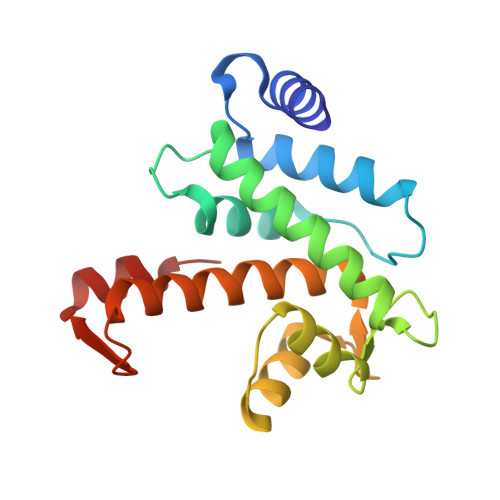Conformationally restricted calpain inhibitors.
Adams, S.E., Robinson, E.J., Miller, D.J., Rizkallah, P.J., Hallett, M.B., Allemann, R.K.(2015) Chem Sci 6: 6865-6871
- PubMed: 28757975
- DOI: https://doi.org/10.1039/c5sc01158b
- Primary Citation of Related Structures:
4WQ2, 4WQ3, 5D69 - PubMed Abstract:
The cysteine protease calpain-I is linked to several diseases and is therefore a valuable target for inhibition. Selective inhibition of calpain-I has proved difficult as most compounds target the active site and inhibit a broad spectrum of cysteine proteases as well as other calpain isoforms. Selective inhibitors might not only be potential drugs but should act as tools to explore the physiological and pathophysiological roles of calpain-I. α-Mercaptoacrylic acid based calpain inhibitors are potent, cell permeable and selective inhibitors of calpain-I and calpain-II. These inhibitors target the calcium binding domain PEF(S) of calpain-I and -II. Here X-ray diffraction analysis of co-crystals of PEF(S) revealed that the disulfide form of an α-mercaptoacrylic acid bound within a hydrophobic groove that is also targeted by a calpastatin inhibitory region and made a greater number of favourable interactions with the protein than the reduced sulfhydryl form. Measurement of the inhibitory potency of the α-mercaptoacrylic acids and X-ray crystallography revealed that the IC 50 values decreased significantly on oxidation as a consequence of the stereo-electronic properties of disulfide bonds that restrict rotation around the S-S bond. Consequently, thioether analogues inhibited calpain-I with potencies similar to those of the free sulfhydryl forms of α-mercaptoacrylic acids.
Organizational Affiliation:
School of Chemistry , Cardiff University , Main Building, Park Place , Cardiff , UK CF10 3AT . Email: allemannrk@cardiff.ac.uk ; ; Tel: +44 (0) 29 2087 9014.
















